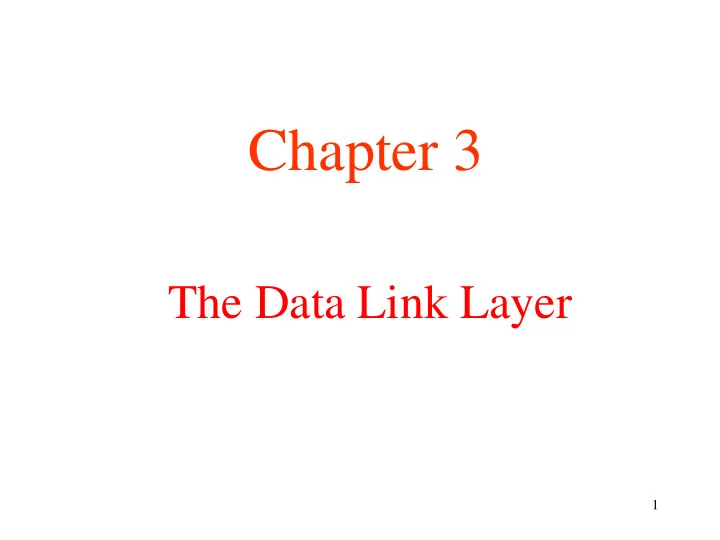

Chapter 3 The Data Link Layer 1
Data Link Layer Design Issues • Services Provided to the Network Layer • Framing • Error Control • Flow Control 2
Functions of the Data Link Layer • Provide service interface to the network layer • Dealing with transmission errors • Regulating data flow • Slow receivers not swamped by fast senders 3
Functions of the Data Link Layer (2) Relationship between packets and frames. 4
Services Provided to Network Layer (a) Virtual communication. (b) Actual communication. 5
Services Provided to Network Layer (2) Placement of the data link protocol. 6
Framing A character stream. (a) Without errors. (b) With one error. 7
Framing (2) (a) A frame delimited by flag bytes. (b) Four examples of byte sequences before and after stuffing. 8
Framing (3) Bit stuffing (a) The original data. (b) The data as they appear on the line. (c) The data as they are stored in receiver’s memory after destuffing. 9
Error Detection and Correction • Error-Correcting Codes • Error-Detecting Codes 10
Error-Correcting Codes Use of a Hamming code to correct burst errors. 11
Error-Detecting Codes Calculation of the polynomial code checksum. 12
Elementary Data Link Protocols • An Unrestricted Simplex Protocol • A Simplex Stop-and-Wait Protocol • A Simplex Protocol for a Noisy Channel 13
Protocol Definitions Continued Some definitions needed in the protocols to follow. These are located in the file protocol.h. 14
Protocol Definitions (ctd.) Some definitions needed in the protocols to follow. These are located in the file protocol.h. 15
Unrestricted Simplex Protocol 16
Simplex Stop-and- Wait Protocol 17
A Simplex Protocol for a Noisy Channel A positive acknowledgement with retransmission protocol. 18 Continued
A Simplex Protocol for a Noisy Channel (ctd.) A positive acknowledgement with retransmission protocol. 19
Sliding Window Protocols • A One-Bit Sliding Window Protocol • A Protocol Using Go Back N • A Protocol Using Selective Repeat 20
Sliding Window Protocols (2) A sliding window of size 1, with a 3-bit sequence number. (a) Initially. (b) After the first frame has been sent. (c) After the first frame has been received. (d) After the first acknowledgement has been received. 21
A One-Bit Sliding Window Protocol 22 Continued
A One-Bit Sliding Window Protocol (ctd.) 23
A One-Bit Sliding Window Protocol (2) Two scenarios for protocol 4. (a) Normal case. (b) Abnormal case. The notation is (seq, ack, packet number). An asterisk indicates where a network layer accepts a packet. 24
A Protocol Using Go Back N Pipelining and error recovery. Effect on an error when (a) Receiver’s window size is 1. (b) Receiver’s window size is large. 25
Sliding Window Protocol Using Go Back N 26 Continued
Sliding Window Protocol Using Go Back N 27 Continued
Sliding Window Protocol Using Go Back N 28 Continued
Sliding Window Protocol Using Go Back N 29
Sliding Window Protocol Using Go Back N (2) Simulation of multiple timers in software. 30
A Sliding Window Protocol Using Selective Repeat 31 Continued
A Sliding Window Protocol Using Selective Repeat (2) 32 Continued
A Sliding Window Protocol Using Selective Repeat (3) 33 Continued
A Sliding Window Protocol Using Selective Repeat (4) 34
A Sliding Window Protocol Using Selective Repeat (5) (a) Initial situation with a window size seven. (b) After seven frames sent and received, but not acknowledged. (c) Initial situation with a window size of four. (d) After four frames sent and received, but not acknowledged. 35
Protocol Verification • Finite State Machined Models • Petri Net Models 36
Finite State Machined Models (a) State diagram for protocol 3. (b) Transmissions. 37
Petri Net Models A Petri net with two places and two transitions. 38
Petri Net Models (2) A Petri net model for protocol 3. 39
Example Data Link Protocols • HDLC – High-Level Data Link Control • The Data Link Layer in the Internet 40
High-Level Data Link Control Frame format for bit-oriented protocols. 41
High-Level Data Link Control (2) Control field of (a) An information frame. (b) A supervisory frame. (c) An unnumbered frame. 42
The Data Link Layer in the Internet A home personal computer acting as an internet host. 43
PPP – Point to Point Protocol The PPP full frame format for unnumbered mode operation. 44
PPP – Point to Point Protocol (2) A simplified phase diagram for bring a line up and down. 45
PPP – Point to Point Protocol (3) The LCP frame types. 46
Recommend
More recommend